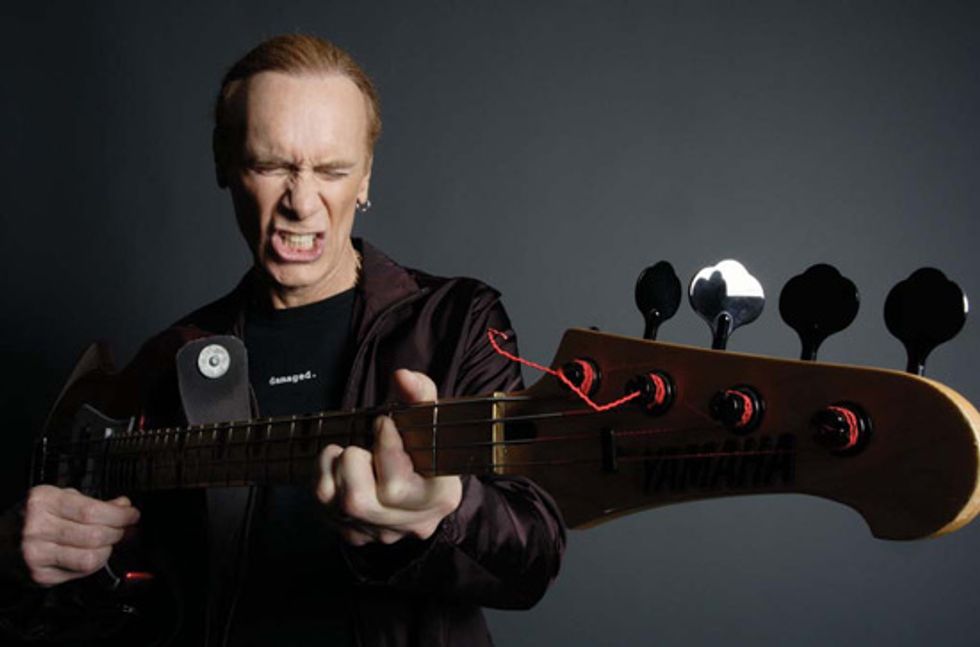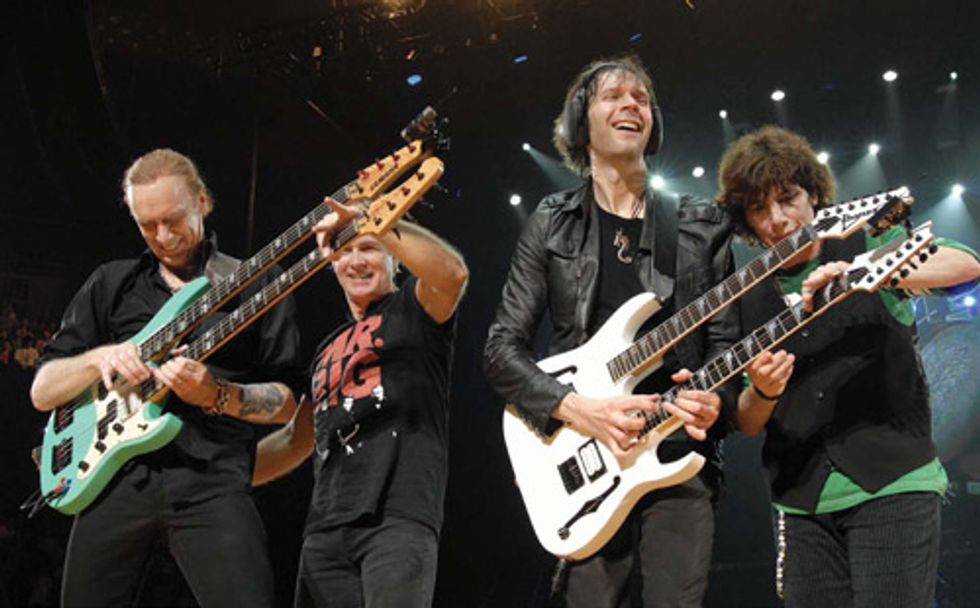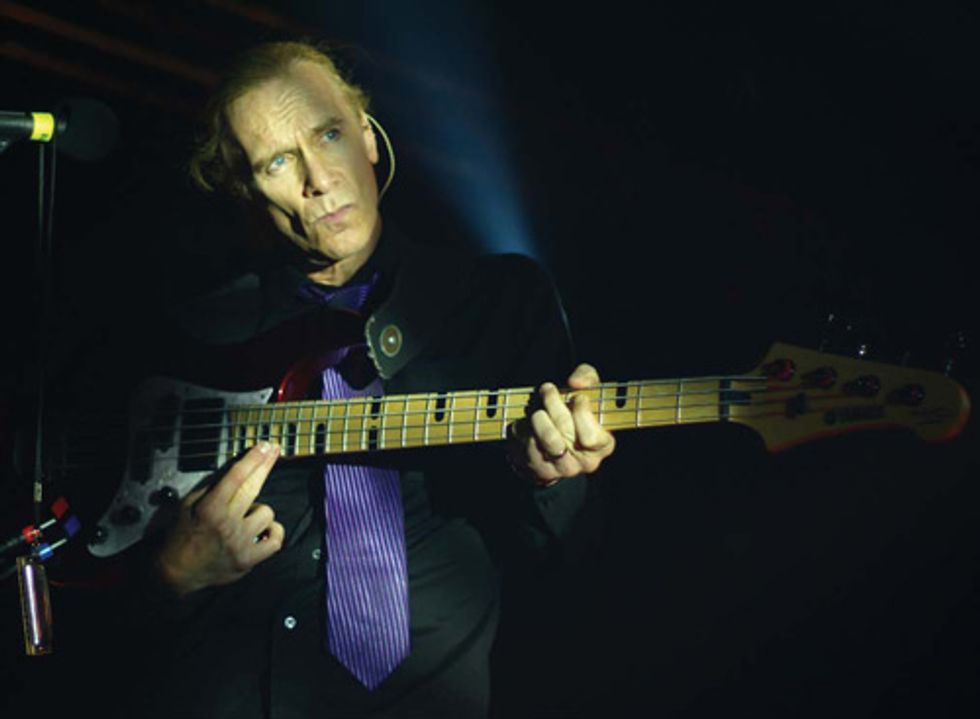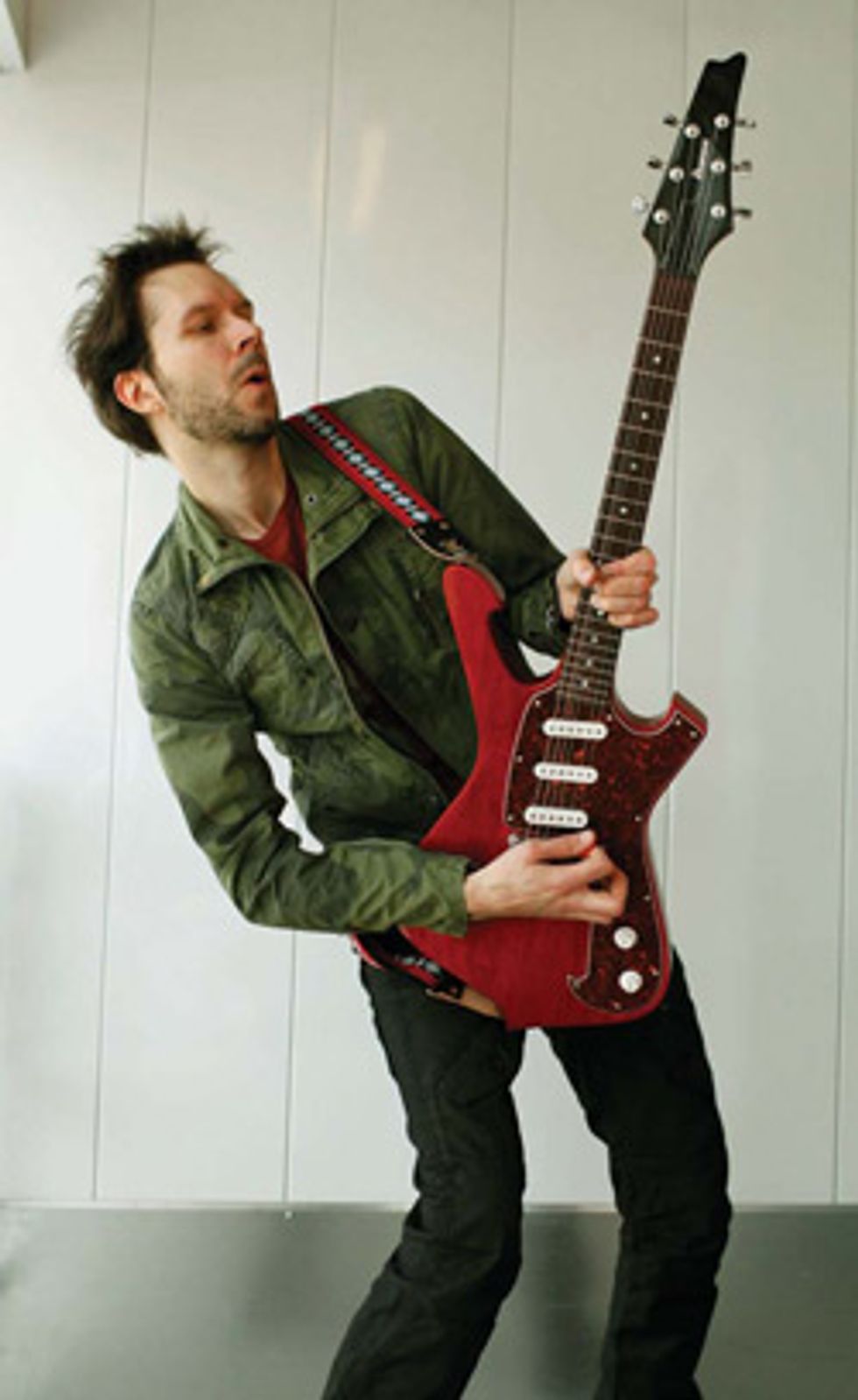Bass god Billy Sheehan talks about recording Mr. Big’s new album, "What If ...," his multi-amp rig, and why it’s important to master your instrument inside and out. Plus! Paul Gilbert chimes in on the new LP’s tones and harmonies.

Photo courtesy of Union Entertainment Management
Mr. Big’s Billy Sheehan may be the modern-day epitome of a rock “lead bassist,” but he never forgets that the bass’ primary role is to put the “roll” in “rock ’n’ roll.” While it’s easy to focus on the over-the-top aspects of Sheehan’s playing, few bassists can hold down a solid low-end like he does. In fact, he’s quick to emphasize that it’s his rock- solid foundation in the groove that allows him to launch his dazzling technique. He’s also a straight-up gearhead with tons of personal experience modifying instruments and designing rigs to create his singular sound.
But Sheehan’s approach to bass extends beyond the mechanics of playing—he’s a big proponent of knowing how to work on your instrument well enough to make it serve your needs as a player. “You have to learn the instrument, learn the fundamentals—how to play it, how to tweak it, how to play strong, hard, in tune, and in time. You need to do all of those things up front, and then you can learn the frosting.”
The “frosting” would be things like the two-handed tapping, chord work, and blazing three-finger plucking that he’s become famous for during his gigs with Mr. Big, David Lee Roth, Niacin (featuring Hammond B-3 master John Novello and virtuoso drummer Dennis Chambers), and Talas. Sheehan’s trademark show-stopping moments onstage and on record are only possible because he has always pushed himself to be a better musician and to redefine what’s achievable with a 4-string bass.
“I know a lot of great players who use 5- and 6-string basses,” says Sheehan, “but you can do just about everything you need to do on a 4-string. I think people think they can solve their problems as players by getting a 5- or 6-string bass, but maybe they haven’t explored all the possibilities of a 4-string.”
Sheehan’s journey began in his native Buffalo, New York. While he was paying his dues with legendary metal band Talas, he developed his high- octane style and an absolutely incredible bass tone. Playing a heavily modified Fender Precision with two outputs he ran through a complex rig, Sheehan created an inspiring bass tone that, paired with groundbreaking technique and showmanship, made him a top candidate for the group that would make him an MTV and radio fixture—David Lee Roth’s solo band. In those post-Van Halen days of 1985, Sheehan was probably the only bassist with enough technique and presence to share a stage with the flamboyant Roth and shred deity Steve Vai on hits like “Yankee Rose” and barn-burning rockers like “Elephant Gun” and “Shyboy.”
After leaving Roth’s group, Sheehan formed Mr. Big in 1988 with former Racer X guitarist Paul Gilbert, vocalist Eric Martin, and drummer Pat Torpey. From the start, Mr. Big focused on powerful lead vocals and rich vocal harmonies that complemented Sheehan and Gilbert’s fretboard pyrotechnics. The formula was popular from the start—especially in Japan, where Mr. Big continues to have a massive following. But it was the band’s second album, ’91’s Lean into It—which included the hugely popular ballad “To Be with You” and the rocking “Green-Tinted Sixties Mind”—that launched the group to the top of the charts in America.
Mr. Big broke up in 2002, but reunited seven years later for a tour that was released as a live album and DVD, both entitled Back to Budokan. Inspired by revitalized chemistry, Sheehan and his mates headed into the studio to record Big’s first studio album in nine years, What If ... Recorded with producer Kevin Shirley (Iron Maiden, Journey, Dream Theater), the new album’s vocal harmonies, glimmering guitar tones, and grinding bass prove the group is still firing on all cylinders.
We recently asked Sheehan and his 6-string cohort, Paul Gilbert, about recording What If ... and the gear they used to get their much-emulated sounds. Both players are veteran clinicians with a lively sense of humor and a generous inclination to share what they’ve learned.

Double the Tapping Fun: Billy Sheehan (far left) shreds on his double-neck Yamaha bass while Mr. Big drummer Pat Torpey capos it at the second fret. Singer Eric Martin does the same for Paul Gilbert and his custom, dual-neck Ibanez. “We’re friendlier now than we ever were,” Sheehan says of the band’s interpersonal dynamic, “and I’m more pleased about that than any sales figures.” Photo courtesy of Union Entertainment Management
What If ... is Mr. Big’s first studio record in nearly 10 years. What’s different this time around?
With age, there is wisdom... I hope [laughs]. I think we’ve all learned to be better communicators, so the whole atmosphere is completely different. The priority was to reestablish the relationships in the band, and I think we succeeded. We’re friendlier now than we ever were, and I’m more pleased about that than any sales figures. If we never sold another record or made another five cents, I’d still consider that a success.
Have those behind-the-scene relationships affected the music?
They have, for one main reason: We decided we were going to evenly split the songwriting credits. In a band situation— especially when everyone is a writer—it really is the best way to do it. This way we all have a stake in every song and work to make each song great.
Have you changed your playing approach this time around?
I’m literally working harder than I have in my entire life, and I’m re-energized on bass. I’m not working on being a faster player, but I’m trying to have supreme command over everything I play. I’m trying to make my playing not something that I can generally pull off—but sometimes not—I’m trying to push myself as far and as hard as I can. It seems like most people will ride on what they’ve already done, but I think this is a great opportunity to use this ride as a stepping-stone to something better. Every time I sit down with my bass, I come up with a few things that I never knew before—things like lines or how to connect notes together.
What was the band’s approach to recording the new record?
Almost everything is a live take. The producer refused to give us the opportunity to go back and replay our parts, so there are almost no bass overdubs— there are maybe 45 seconds of bass fixes on the record. On one hand, the energy of a band performing together is the way a record should be, but doing it that way is scary. It can lead to a lot of takes. I worried that I wouldn’t be able to pull off some of the difficult technical parts sitting next to a drum set and a guitar amp and playing by feel instead of listening to every note in the control room. Sometimes music has to be precarious—if it’s too easy and too automatic, then it’s not art to me.
Which part on the record really pushed your boundaries?
There’s a tricky part on “Around the World” that Paul and I play together. We modified it with a whole new part the day before recording it. Not only did we have to articulate the new part, we had to remember it and play it together as a band, because the way we were recording wouldn’t allow us to punch it in piece by piece. We stuck with actually performing it together, with the band, and doing it right. I tore my hands to pieces, because I play really hard. I love that, because it shows me that I’m working. When there are flecks of skin flying around, that’s when I know real work is happening.
Judging by online video clips of you playing, it looks like you play really hard.
I dig in really hard. Bass is a strength instrument, and I try to teach people at clinics to get as much sound off that string as they can and to not rely so much on the pickups and amps. To get that string sound, you have to hit it hard.
Do you have a special setup to help you with your heavy attack?
Not really, but I constantly tweak my bass. When I’m on tour, I start with a light action, but after a week I get stronger and I start to overwhelm the low action. I end up not get- ting notes—just fret buzz—so I keep raising the action as the tour continues. By the end of a tour, my bass’s action is set pretty high.
Back in the day, we had to figure out how to set up our instruments by ourselves. I’m glad I learned how to set my pickup height, adjust the action, and dress my frets. Basically, I’m able to fine-tune my bass to where it’s most comfortable to me. Opening up the bass and learning what’s going on inside really helps me know my instrument. The more command you have over your instrument—inside and out— the more confident you’ll be as a player. And confidence is an artistic advantage.
Do you ever suffer playing-related injuries, and if so, how do you deal with them?
I had wrist problems for years. It didn’t affect my playing very much. I could barely move my wrists, but I went on a low-carb diet and it’s completely cured. I’ve advised many musicians over the years to try this, and pretty much all of them are cured. High carbs, high glucose, and joints do not work together well. Everyone is different, and one cure won’t work for everyone, but the anecdotal evidence seems really strong. Another issue from playing hard is that the fingernails on my picking hand start to separate out from my fingers. Man—is that painful. I actually superglue them back on.
You’ve had success in a number of different playing situations. As a musician, what makes Mr. Big different than the others?
It’s the most all-around, regular rock band that I’ve been in. Talas was cool, but it had its limitations. I really enjoyed playing with David Lee Roth, he’s a great frontman, but it was his band. But with Mr. Big, we’re all singing and playing. All of my favorite bands— like Grand Funk Railroad, Humble Pie, Spooky Tooth, and Free—are all about singing and playing. There’s song structure. And that’s how we modeled Mr. Big in the beginning. We even took our name from a Free song. The real attraction of Mr. Big, to me, is that it’s a regular old rock band where we can sing and play. I got caught up in a lot of progressive and instrumental stuff, which I really like, but I always gravitate toward sitting around with friends, opening a bottle of wine, and singing songs. We’re not going to play metal, we’re going to sing. Singing is what we use to reach people. You can reach some people with an instrumental band, but if you have good instrumental work with singing on top of it, then you can reach a whole other, larger audience.
Singing while playing bass is much more difficult than playing guitar. Why is it harder, and do you still have to work on it?
I can strum a guitar and sing all day long, but with bass there’s something about the articulation of your plucking hand and singing that I have to work on all of the time. When I see someone like Esperanza Spalding doing it, I feel like giving up.

Spanish Scallop Magic: Sheehan takes advantage of his Yamaha Attitude signature model’s scalloped frets while engaging in some of his trademark chord work onstage at Rockstar Live in Bilbao, Spain, on September 19, 2009. Photo by Koldo Orue
What do you do to overcome that difficulty?
I get comfortable with the bass playing first, then I add the singing. Basically, I just start making mistakes. I keep going over the part and fixing the mistakes until it falls together. You have to do it until it’s second nature. We toured with Rush, and Geddy [Lee, vocalist and bassist]—who’s a supreme master at his craft—admitted to me that before a tour he has to work on being able to sing and play. The answer is always that you have to spend time on it to be able to hit it hard.
You have such a powerful and distinctive sound. Besides your fingers, what do you need to sound like Billy Sheehan?
The dual output of the bass is one of my secret weapons. Each pickup has a dedicated amp and cabinet. My sound breaks down into a clean, bright sound with not much low end, a distorted sound without much low-end, and a separate amp with just super-deep lows. I mix those three together to get articulation, harmonic content, and deep low end.
The neck pickup on my bass is modeled after the Gibson EB-0 sound and that big, deep, Paul McCartney-like tone runs through a Hartke LH1000 head and AK410 4x10 cabinet. I don’t need much tone shaping on the lows—I need power. The highs and grind come from the P pickup, which I run through a Hartke HA5500C head and AK115 1x15 cab. I run the P pickup’s signal through two channels of a Pearce BC1 pre-amp. One channel is clean and one is distorted. The clean is always on full volume, and the distortion channel is switchable. Each system runs through an Ashly Audio SC-50 compressor.
I use the 4x10 for lows and the 1x15 for highs—which is backwards from what most people do. I find that the surface area of 15" speakers disperses high frequencies in a softer, less shrill way. The smaller surface area of 10" speakers is good for fast, tight lows. I want the low frequencies to be super fast, because if they’re not, they get left behind and the sound is mushy.
Tell me about the scalloped fretboard on your signature Yamaha Attitude bass.
In the summer of ’85, Talas toured with Yngwie [Malmsteen], and he had scalloped frets on his Strat. I was so impressed with his complete mastery of the instrument that I wanted to try scalloping the frets on my old P bass. I didn’t want to take that much wood off of the neck, so I went halfway across the fretboard’s last five frets with a Dremel. Anyone can bend with or without the scallops, but I found they make it a little easier to bend the high notes. When Yamaha did the new Attitude basses, they decided to include all of my hotel-room repairs—only they did them a lot more professionally [laughs].
Over the years, you’ve taught a lot of seminars and clinics. Are there certain questions you get asked often?
People always ask about my three-finger technique on my right hand. I always say “I’ll coach you through anything you want, but before I do, how badly do you need to use three fingers at this point in your career?” People usually get the point. In the weeks before Mr. Big starts its full-on rehearsals, [drummer] Pat Torpey and I work on the drum and bass moves, getting the idea of where everything should land. Then Paul Gilbert comes in and we work him in before we set up for the full band. But a lot of guys who come to clinics want to jump ahead and learn some big technique before they even know what the bass drum is doing. I try to get them to pay attention to the snare and the bass drum and understand what they are doing before worrying about using three fingers.
Billy Sheehan’s Gearbox
Basses
Yamaha Attitude Ltd. II 4-string basses
Amps and Cabinets
Hartke LH1000 head driving a Hartke AK410 4x10 cabinet, Hartke HA5500C head powering a Hartke AK115 1x15 cab
Effects
Ashly Audio SC-50 compressor, Pearce BC1 preamp
Strings and Picks
Rotosound Billy Sheehan Signature stainless-steel roundwound strings (.043–.110), Real Rock stone picks
Miscellaneous
DiMarzio Stereo Guitar Cable, DiMarzio M-Path Interconnect, DiMarzio Jumper Cable, and DiMarzio High Definition and Super M-Path speaker cables
Paul Gilbert on Recording What If ...
 |
You’re involved with a lot of projects— from Mr. big to solo records, teaching, and racer X reunions. What’s especially challenging about playing with Mr. big?
Mr. Big has heavy songs, ballads, and everything in between, so it’s a challenge to get the right sound for each song. I need a big, crunchy metal sound for “Daddy, Brother, Lover, Little Boy,” where “Just Take My Heart” is super clean and compressed. “Green-Tinted Sixties Mind” and “Take Cover” are more jangly, so I have to find a balance between a clean sound with enough overdrive to still make it rock. And there’s “To Be With You,” which is acoustic. I wonder if any- one would notice the difference if I used the same sound for everything or if I’m just giving myself a complicated hobby because I like to mess around with gear?
What’s your favorite aspect of the new record?
I think the songs will sound great live, because they were basically recorded that way. But one of my favorite things about Mr. Big is the vocal harmonies—I love playing and singing.
“Once upon a Time” features a heavy drop-d riff. do you write much in non- standard tunings?
I’m mostly scared of different tunings. I’ve invested so much time into learning to play in standard tuning that it’s a little depress- ing to start over with new shapes in a new tuning. But “Once upon a Time” is man- ageable because only one string is different.
I hear a lot of single-coil sounds on What If ... . in a genre that’s pretty humbucker-centric, what draws you to the sound of single-coils?
I saw Frank Marino play a few years ago, and he had two Gibson SGs: One with the humbuckers and one with three single-coils. The single-coil guitar had a lot more clarity and just sounded better overall. That inspired me to put single-coils in the Ibanez Fireman gui- tar that I was designing at the time. I think that they offer a good balance of clarity and thickness. I used it on the new Mr. Big record as well as my last solo record, Fuzz Universe.
Paul Gilbert’s Gearbox
Guitars
Ibanez PGMFRM1 Fireman, Ibanez PGM401 Paul Gilbert signature model, 1979 Ibanez Artist 2630 semi-hollowbody, Ibanez PM100 Pat Metheny signature hollowbody, Ibanez custom shop PGM 12-string
Amps
Marshall 2266c Vintage Modern 50-watt 2x12 combo, THD Hot Plate
Strings and Picks
Ernie Ball RPS-11 Slinkys (for Mr. Big songs tuned down to Eb), Ernie Ball RPS-10 Slinkys (for standard tuning), Tortex .60 mm picks
Effects
Majik Box Fuzz Universe, Ibanez Paul Gilbert Signature AF2 Airplane Flanger, HomeBrew Detox EQ, MXR Phase 90, Fulltone ChoralFlange, ADA Flanger, HomeBrew CPR compressor

